Comparison of Business Law and Dispute Resolution
VerifiedAdded on 2020/10/23
|14
|4438
|149
AI Summary
The assignment provided is a comparison of business law and alternative dispute resolution (ADR) in the UK. It discusses the sources of law, including legislation, case laws, and EU laws, as well as recent reforms in the English legal system. The document also explores the different types of business organizations, such as sole trader, partnership, and limited company, and examines methods of ADR like arbitration, mediation, and negotiation.
Contribute Materials
Your contribution can guide someone’s learning journey. Share your
documents today.
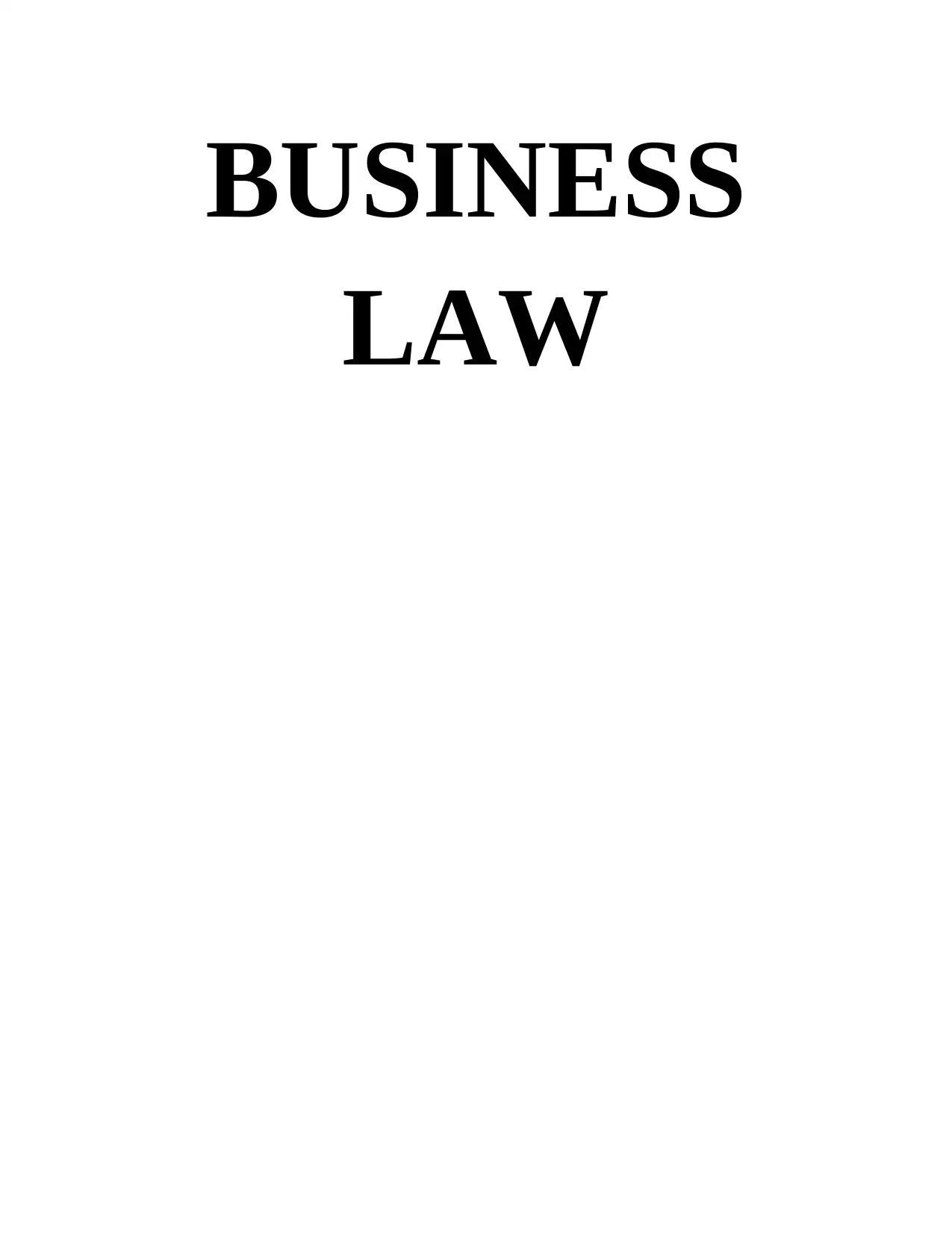
BUSINESS
LAW
LAW
Secure Best Marks with AI Grader
Need help grading? Try our AI Grader for instant feedback on your assignments.
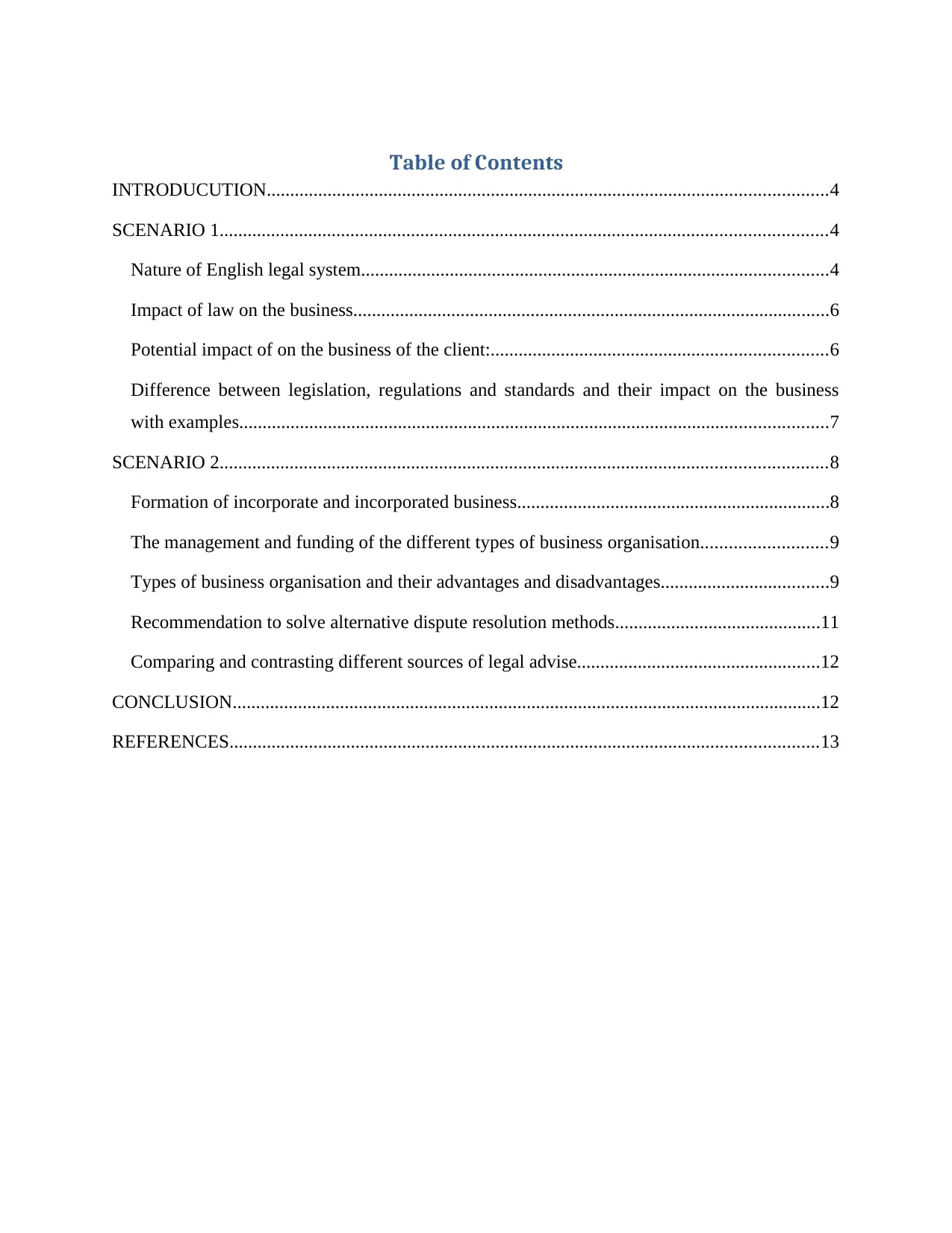
Table of Contents
INTRODUCUTION........................................................................................................................4
SCENARIO 1..................................................................................................................................4
Nature of English legal system....................................................................................................4
Impact of law on the business......................................................................................................6
Potential impact of on the business of the client:........................................................................6
Difference between legislation, regulations and standards and their impact on the business
with examples..............................................................................................................................7
SCENARIO 2..................................................................................................................................8
Formation of incorporate and incorporated business...................................................................8
The management and funding of the different types of business organisation...........................9
Types of business organisation and their advantages and disadvantages....................................9
Recommendation to solve alternative dispute resolution methods............................................11
Comparing and contrasting different sources of legal advise....................................................12
CONCLUSION..............................................................................................................................12
REFERENCES..............................................................................................................................13
INTRODUCUTION........................................................................................................................4
SCENARIO 1..................................................................................................................................4
Nature of English legal system....................................................................................................4
Impact of law on the business......................................................................................................6
Potential impact of on the business of the client:........................................................................6
Difference between legislation, regulations and standards and their impact on the business
with examples..............................................................................................................................7
SCENARIO 2..................................................................................................................................8
Formation of incorporate and incorporated business...................................................................8
The management and funding of the different types of business organisation...........................9
Types of business organisation and their advantages and disadvantages....................................9
Recommendation to solve alternative dispute resolution methods............................................11
Comparing and contrasting different sources of legal advise....................................................12
CONCLUSION..............................................................................................................................12
REFERENCES..............................................................................................................................13

b
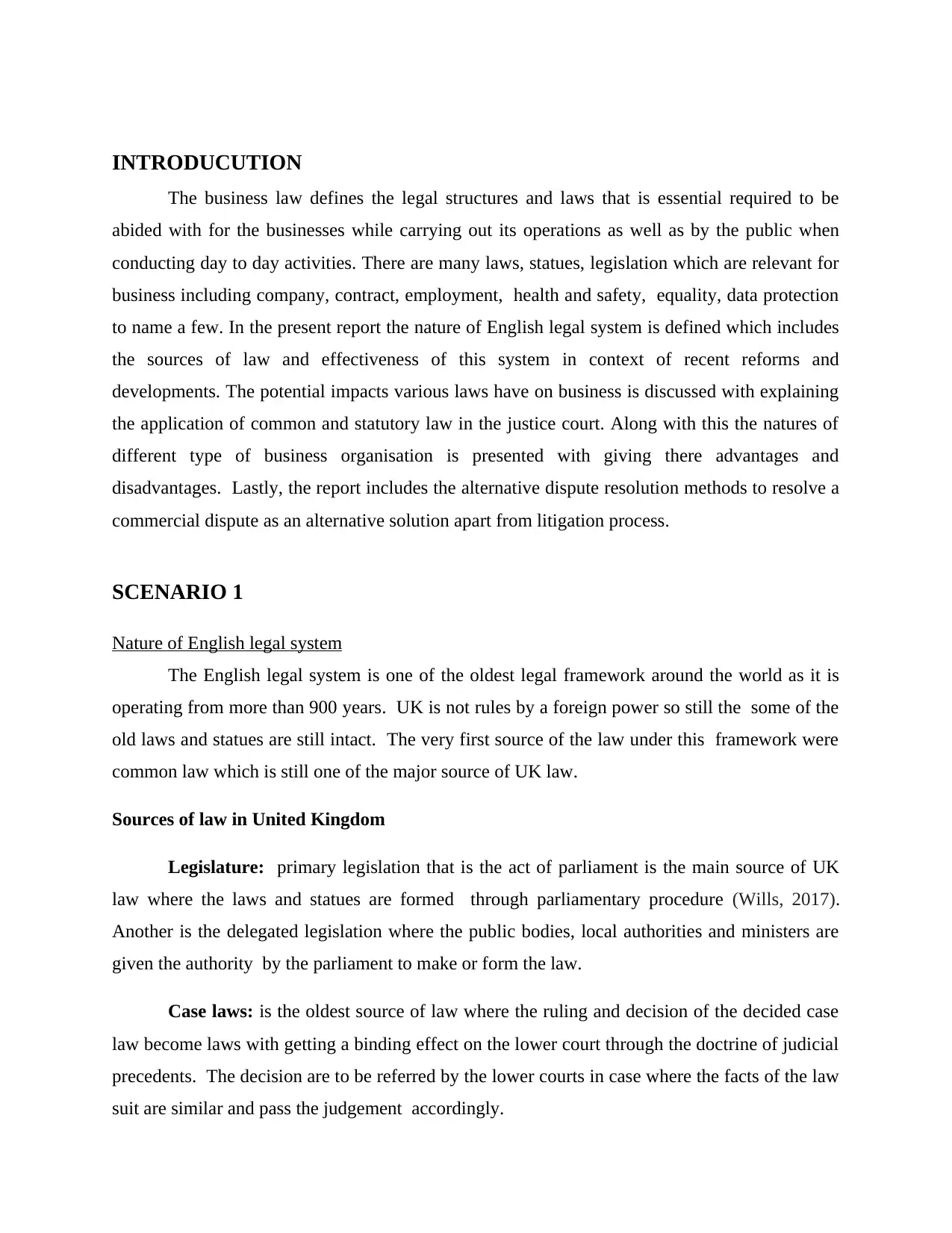
INTRODUCUTION
The business law defines the legal structures and laws that is essential required to be
abided with for the businesses while carrying out its operations as well as by the public when
conducting day to day activities. There are many laws, statues, legislation which are relevant for
business including company, contract, employment, health and safety, equality, data protection
to name a few. In the present report the nature of English legal system is defined which includes
the sources of law and effectiveness of this system in context of recent reforms and
developments. The potential impacts various laws have on business is discussed with explaining
the application of common and statutory law in the justice court. Along with this the natures of
different type of business organisation is presented with giving there advantages and
disadvantages. Lastly, the report includes the alternative dispute resolution methods to resolve a
commercial dispute as an alternative solution apart from litigation process.
SCENARIO 1
Nature of English legal system
The English legal system is one of the oldest legal framework around the world as it is
operating from more than 900 years. UK is not rules by a foreign power so still the some of the
old laws and statues are still intact. The very first source of the law under this framework were
common law which is still one of the major source of UK law.
Sources of law in United Kingdom
Legislature: primary legislation that is the act of parliament is the main source of UK
law where the laws and statues are formed through parliamentary procedure (Wills, 2017).
Another is the delegated legislation where the public bodies, local authorities and ministers are
given the authority by the parliament to make or form the law.
Case laws: is the oldest source of law where the ruling and decision of the decided case
law become laws with getting a binding effect on the lower court through the doctrine of judicial
precedents. The decision are to be referred by the lower courts in case where the facts of the law
suit are similar and pass the judgement accordingly.
The business law defines the legal structures and laws that is essential required to be
abided with for the businesses while carrying out its operations as well as by the public when
conducting day to day activities. There are many laws, statues, legislation which are relevant for
business including company, contract, employment, health and safety, equality, data protection
to name a few. In the present report the nature of English legal system is defined which includes
the sources of law and effectiveness of this system in context of recent reforms and
developments. The potential impacts various laws have on business is discussed with explaining
the application of common and statutory law in the justice court. Along with this the natures of
different type of business organisation is presented with giving there advantages and
disadvantages. Lastly, the report includes the alternative dispute resolution methods to resolve a
commercial dispute as an alternative solution apart from litigation process.
SCENARIO 1
Nature of English legal system
The English legal system is one of the oldest legal framework around the world as it is
operating from more than 900 years. UK is not rules by a foreign power so still the some of the
old laws and statues are still intact. The very first source of the law under this framework were
common law which is still one of the major source of UK law.
Sources of law in United Kingdom
Legislature: primary legislation that is the act of parliament is the main source of UK
law where the laws and statues are formed through parliamentary procedure (Wills, 2017).
Another is the delegated legislation where the public bodies, local authorities and ministers are
given the authority by the parliament to make or form the law.
Case laws: is the oldest source of law where the ruling and decision of the decided case
law become laws with getting a binding effect on the lower court through the doctrine of judicial
precedents. The decision are to be referred by the lower courts in case where the facts of the law
suit are similar and pass the judgement accordingly.
Secure Best Marks with AI Grader
Need help grading? Try our AI Grader for instant feedback on your assignments.
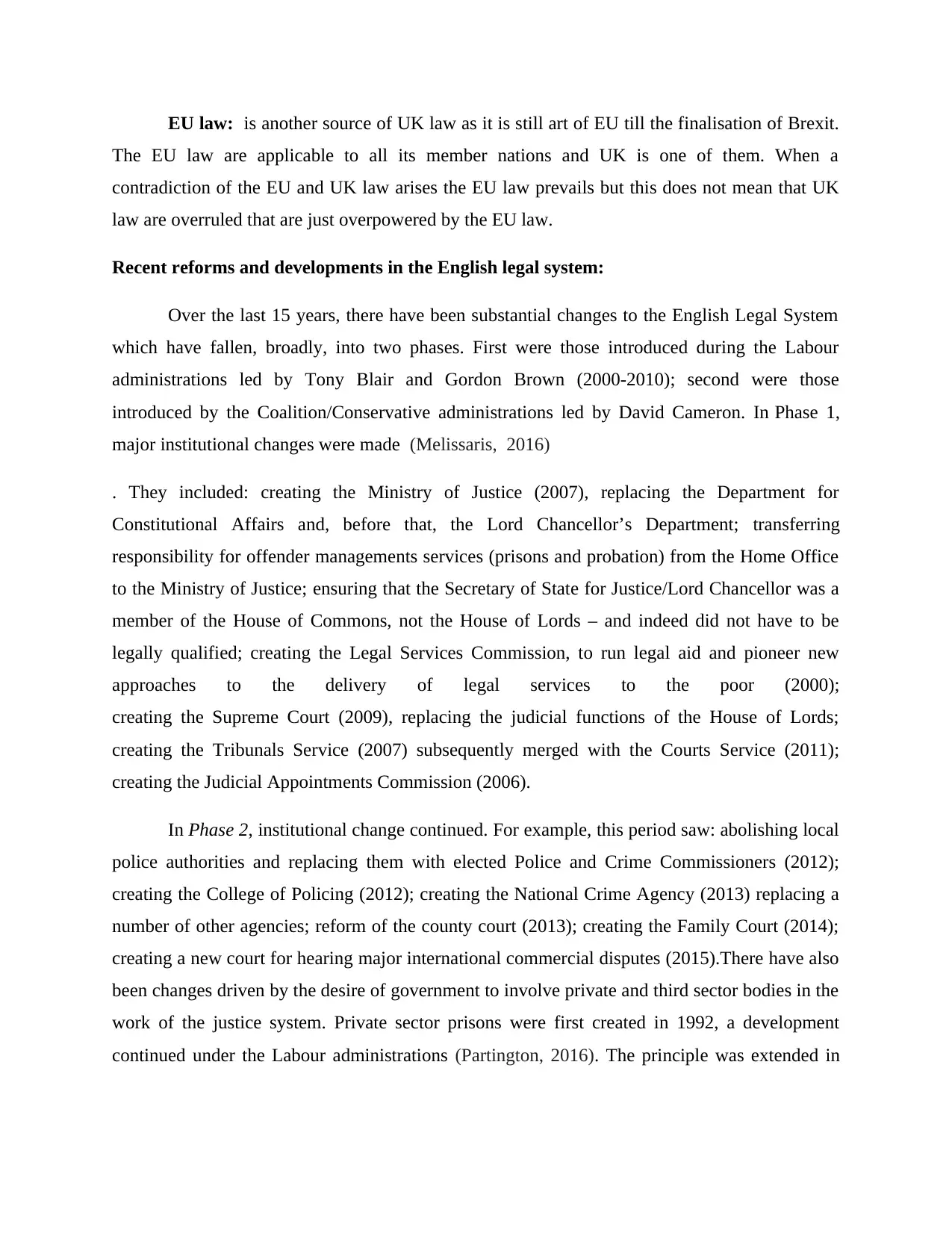
EU law: is another source of UK law as it is still art of EU till the finalisation of Brexit.
The EU law are applicable to all its member nations and UK is one of them. When a
contradiction of the EU and UK law arises the EU law prevails but this does not mean that UK
law are overruled that are just overpowered by the EU law.
Recent reforms and developments in the English legal system:
Over the last 15 years, there have been substantial changes to the English Legal System
which have fallen, broadly, into two phases. First were those introduced during the Labour
administrations led by Tony Blair and Gordon Brown (2000-2010); second were those
introduced by the Coalition/Conservative administrations led by David Cameron. In Phase 1,
major institutional changes were made (Melissaris, 2016)
. They included: creating the Ministry of Justice (2007), replacing the Department for
Constitutional Affairs and, before that, the Lord Chancellor’s Department; transferring
responsibility for offender managements services (prisons and probation) from the Home Office
to the Ministry of Justice; ensuring that the Secretary of State for Justice/Lord Chancellor was a
member of the House of Commons, not the House of Lords – and indeed did not have to be
legally qualified; creating the Legal Services Commission, to run legal aid and pioneer new
approaches to the delivery of legal services to the poor (2000);
creating the Supreme Court (2009), replacing the judicial functions of the House of Lords;
creating the Tribunals Service (2007) subsequently merged with the Courts Service (2011);
creating the Judicial Appointments Commission (2006).
In Phase 2, institutional change continued. For example, this period saw: abolishing local
police authorities and replacing them with elected Police and Crime Commissioners (2012);
creating the College of Policing (2012); creating the National Crime Agency (2013) replacing a
number of other agencies; reform of the county court (2013); creating the Family Court (2014);
creating a new court for hearing major international commercial disputes (2015).There have also
been changes driven by the desire of government to involve private and third sector bodies in the
work of the justice system. Private sector prisons were first created in 1992, a development
continued under the Labour administrations (Partington, 2016). The principle was extended in
The EU law are applicable to all its member nations and UK is one of them. When a
contradiction of the EU and UK law arises the EU law prevails but this does not mean that UK
law are overruled that are just overpowered by the EU law.
Recent reforms and developments in the English legal system:
Over the last 15 years, there have been substantial changes to the English Legal System
which have fallen, broadly, into two phases. First were those introduced during the Labour
administrations led by Tony Blair and Gordon Brown (2000-2010); second were those
introduced by the Coalition/Conservative administrations led by David Cameron. In Phase 1,
major institutional changes were made (Melissaris, 2016)
. They included: creating the Ministry of Justice (2007), replacing the Department for
Constitutional Affairs and, before that, the Lord Chancellor’s Department; transferring
responsibility for offender managements services (prisons and probation) from the Home Office
to the Ministry of Justice; ensuring that the Secretary of State for Justice/Lord Chancellor was a
member of the House of Commons, not the House of Lords – and indeed did not have to be
legally qualified; creating the Legal Services Commission, to run legal aid and pioneer new
approaches to the delivery of legal services to the poor (2000);
creating the Supreme Court (2009), replacing the judicial functions of the House of Lords;
creating the Tribunals Service (2007) subsequently merged with the Courts Service (2011);
creating the Judicial Appointments Commission (2006).
In Phase 2, institutional change continued. For example, this period saw: abolishing local
police authorities and replacing them with elected Police and Crime Commissioners (2012);
creating the College of Policing (2012); creating the National Crime Agency (2013) replacing a
number of other agencies; reform of the county court (2013); creating the Family Court (2014);
creating a new court for hearing major international commercial disputes (2015).There have also
been changes driven by the desire of government to involve private and third sector bodies in the
work of the justice system. Private sector prisons were first created in 1992, a development
continued under the Labour administrations (Partington, 2016). The principle was extended in
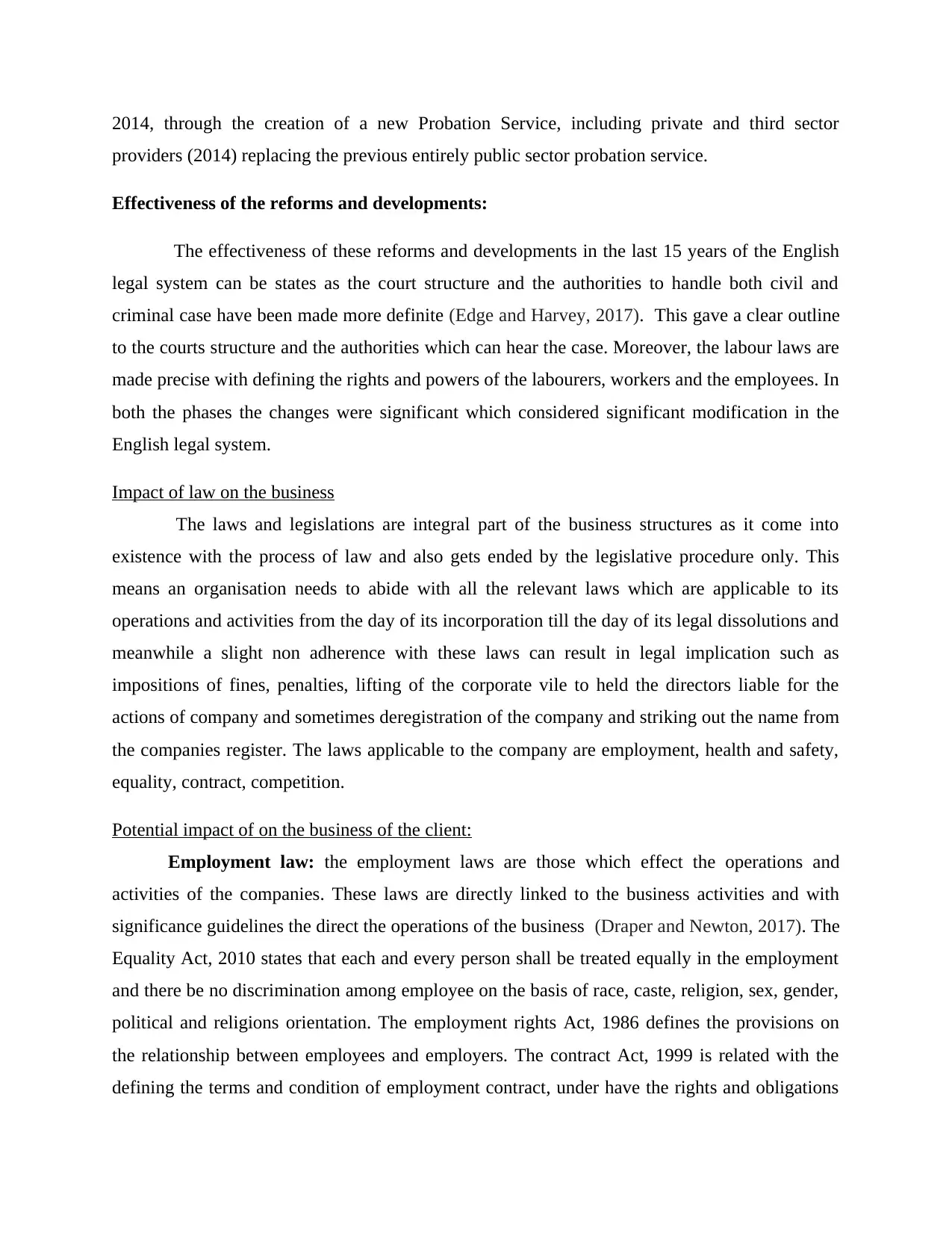
2014, through the creation of a new Probation Service, including private and third sector
providers (2014) replacing the previous entirely public sector probation service.
Effectiveness of the reforms and developments:
The effectiveness of these reforms and developments in the last 15 years of the English
legal system can be states as the court structure and the authorities to handle both civil and
criminal case have been made more definite (Edge and Harvey, 2017). This gave a clear outline
to the courts structure and the authorities which can hear the case. Moreover, the labour laws are
made precise with defining the rights and powers of the labourers, workers and the employees. In
both the phases the changes were significant which considered significant modification in the
English legal system.
Impact of law on the business
The laws and legislations are integral part of the business structures as it come into
existence with the process of law and also gets ended by the legislative procedure only. This
means an organisation needs to abide with all the relevant laws which are applicable to its
operations and activities from the day of its incorporation till the day of its legal dissolutions and
meanwhile a slight non adherence with these laws can result in legal implication such as
impositions of fines, penalties, lifting of the corporate vile to held the directors liable for the
actions of company and sometimes deregistration of the company and striking out the name from
the companies register. The laws applicable to the company are employment, health and safety,
equality, contract, competition.
Potential impact of on the business of the client:
Employment law: the employment laws are those which effect the operations and
activities of the companies. These laws are directly linked to the business activities and with
significance guidelines the direct the operations of the business (Draper and Newton, 2017). The
Equality Act, 2010 states that each and every person shall be treated equally in the employment
and there be no discrimination among employee on the basis of race, caste, religion, sex, gender,
political and religions orientation. The employment rights Act, 1986 defines the provisions on
the relationship between employees and employers. The contract Act, 1999 is related with the
defining the terms and condition of employment contract, under have the rights and obligations
providers (2014) replacing the previous entirely public sector probation service.
Effectiveness of the reforms and developments:
The effectiveness of these reforms and developments in the last 15 years of the English
legal system can be states as the court structure and the authorities to handle both civil and
criminal case have been made more definite (Edge and Harvey, 2017). This gave a clear outline
to the courts structure and the authorities which can hear the case. Moreover, the labour laws are
made precise with defining the rights and powers of the labourers, workers and the employees. In
both the phases the changes were significant which considered significant modification in the
English legal system.
Impact of law on the business
The laws and legislations are integral part of the business structures as it come into
existence with the process of law and also gets ended by the legislative procedure only. This
means an organisation needs to abide with all the relevant laws which are applicable to its
operations and activities from the day of its incorporation till the day of its legal dissolutions and
meanwhile a slight non adherence with these laws can result in legal implication such as
impositions of fines, penalties, lifting of the corporate vile to held the directors liable for the
actions of company and sometimes deregistration of the company and striking out the name from
the companies register. The laws applicable to the company are employment, health and safety,
equality, contract, competition.
Potential impact of on the business of the client:
Employment law: the employment laws are those which effect the operations and
activities of the companies. These laws are directly linked to the business activities and with
significance guidelines the direct the operations of the business (Draper and Newton, 2017). The
Equality Act, 2010 states that each and every person shall be treated equally in the employment
and there be no discrimination among employee on the basis of race, caste, religion, sex, gender,
political and religions orientation. The employment rights Act, 1986 defines the provisions on
the relationship between employees and employers. The contract Act, 1999 is related with the
defining the terms and condition of employment contract, under have the rights and obligations
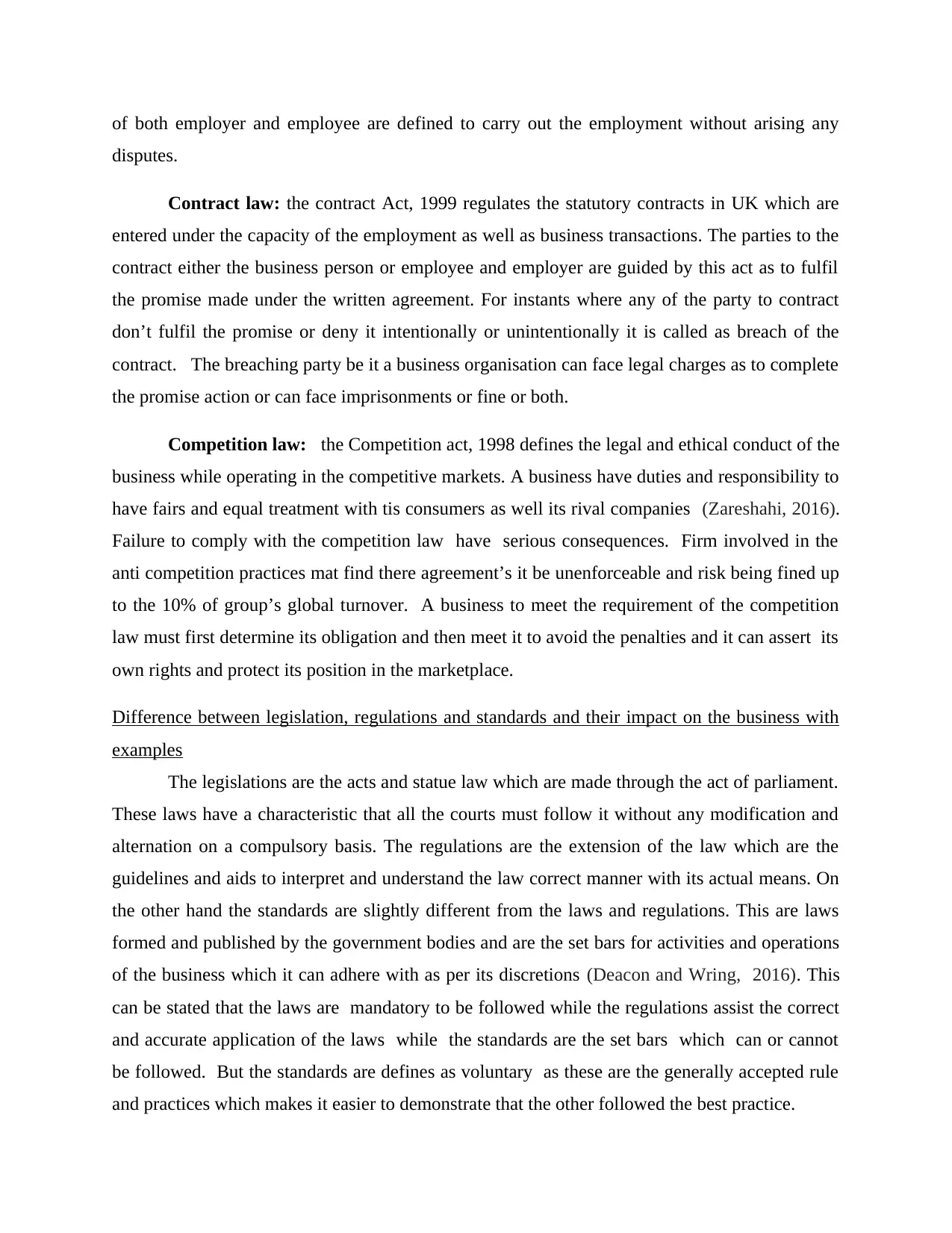
of both employer and employee are defined to carry out the employment without arising any
disputes.
Contract law: the contract Act, 1999 regulates the statutory contracts in UK which are
entered under the capacity of the employment as well as business transactions. The parties to the
contract either the business person or employee and employer are guided by this act as to fulfil
the promise made under the written agreement. For instants where any of the party to contract
don’t fulfil the promise or deny it intentionally or unintentionally it is called as breach of the
contract. The breaching party be it a business organisation can face legal charges as to complete
the promise action or can face imprisonments or fine or both.
Competition law: the Competition act, 1998 defines the legal and ethical conduct of the
business while operating in the competitive markets. A business have duties and responsibility to
have fairs and equal treatment with tis consumers as well its rival companies (Zareshahi, 2016).
Failure to comply with the competition law have serious consequences. Firm involved in the
anti competition practices mat find there agreement’s it be unenforceable and risk being fined up
to the 10% of group’s global turnover. A business to meet the requirement of the competition
law must first determine its obligation and then meet it to avoid the penalties and it can assert its
own rights and protect its position in the marketplace.
Difference between legislation, regulations and standards and their impact on the business with
examples
The legislations are the acts and statue law which are made through the act of parliament.
These laws have a characteristic that all the courts must follow it without any modification and
alternation on a compulsory basis. The regulations are the extension of the law which are the
guidelines and aids to interpret and understand the law correct manner with its actual means. On
the other hand the standards are slightly different from the laws and regulations. This are laws
formed and published by the government bodies and are the set bars for activities and operations
of the business which it can adhere with as per its discretions (Deacon and Wring, 2016). This
can be stated that the laws are mandatory to be followed while the regulations assist the correct
and accurate application of the laws while the standards are the set bars which can or cannot
be followed. But the standards are defines as voluntary as these are the generally accepted rule
and practices which makes it easier to demonstrate that the other followed the best practice.
disputes.
Contract law: the contract Act, 1999 regulates the statutory contracts in UK which are
entered under the capacity of the employment as well as business transactions. The parties to the
contract either the business person or employee and employer are guided by this act as to fulfil
the promise made under the written agreement. For instants where any of the party to contract
don’t fulfil the promise or deny it intentionally or unintentionally it is called as breach of the
contract. The breaching party be it a business organisation can face legal charges as to complete
the promise action or can face imprisonments or fine or both.
Competition law: the Competition act, 1998 defines the legal and ethical conduct of the
business while operating in the competitive markets. A business have duties and responsibility to
have fairs and equal treatment with tis consumers as well its rival companies (Zareshahi, 2016).
Failure to comply with the competition law have serious consequences. Firm involved in the
anti competition practices mat find there agreement’s it be unenforceable and risk being fined up
to the 10% of group’s global turnover. A business to meet the requirement of the competition
law must first determine its obligation and then meet it to avoid the penalties and it can assert its
own rights and protect its position in the marketplace.
Difference between legislation, regulations and standards and their impact on the business with
examples
The legislations are the acts and statue law which are made through the act of parliament.
These laws have a characteristic that all the courts must follow it without any modification and
alternation on a compulsory basis. The regulations are the extension of the law which are the
guidelines and aids to interpret and understand the law correct manner with its actual means. On
the other hand the standards are slightly different from the laws and regulations. This are laws
formed and published by the government bodies and are the set bars for activities and operations
of the business which it can adhere with as per its discretions (Deacon and Wring, 2016). This
can be stated that the laws are mandatory to be followed while the regulations assist the correct
and accurate application of the laws while the standards are the set bars which can or cannot
be followed. But the standards are defines as voluntary as these are the generally accepted rule
and practices which makes it easier to demonstrate that the other followed the best practice.
Paraphrase This Document
Need a fresh take? Get an instant paraphrase of this document with our AI Paraphraser
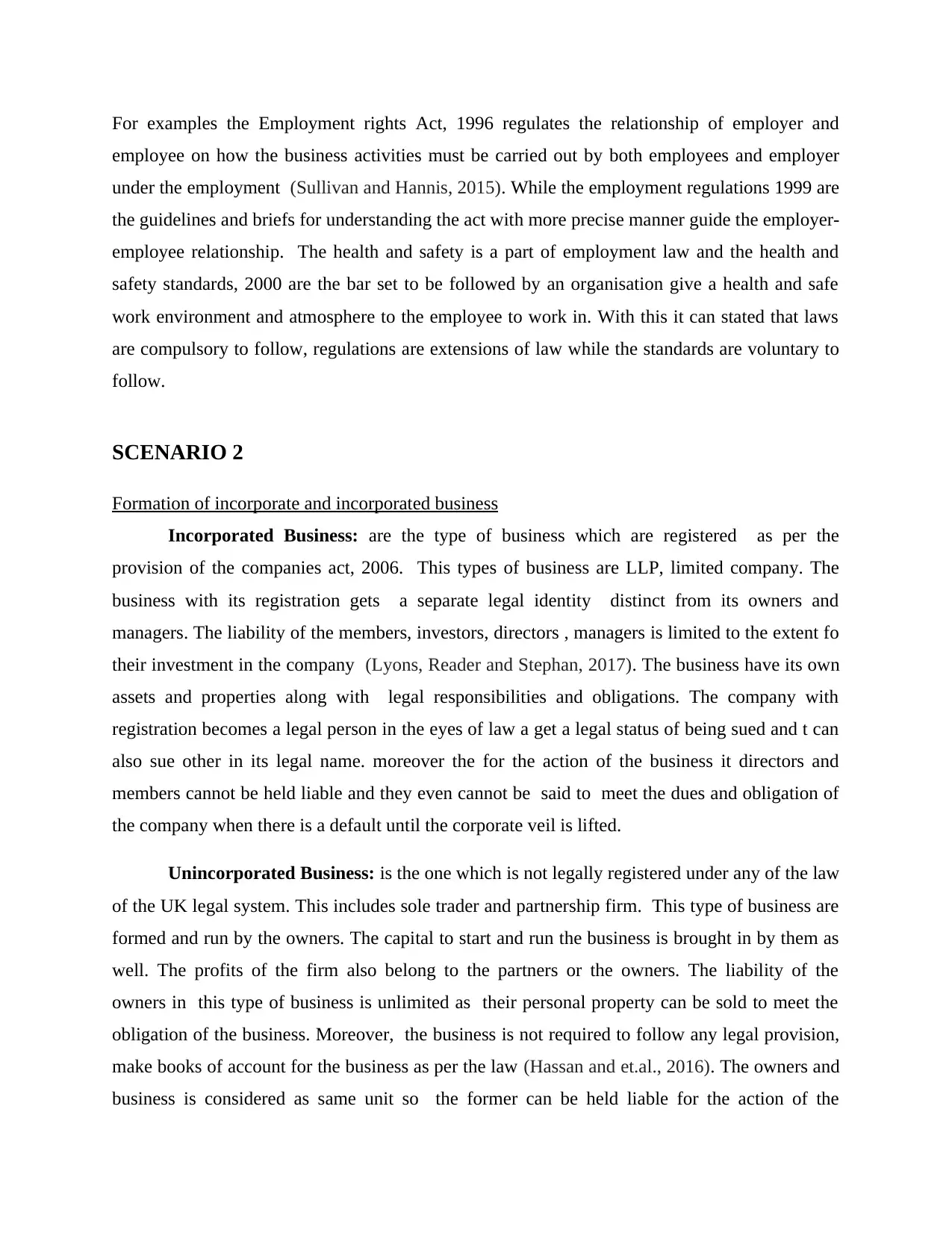
For examples the Employment rights Act, 1996 regulates the relationship of employer and
employee on how the business activities must be carried out by both employees and employer
under the employment (Sullivan and Hannis, 2015). While the employment regulations 1999 are
the guidelines and briefs for understanding the act with more precise manner guide the employer-
employee relationship. The health and safety is a part of employment law and the health and
safety standards, 2000 are the bar set to be followed by an organisation give a health and safe
work environment and atmosphere to the employee to work in. With this it can stated that laws
are compulsory to follow, regulations are extensions of law while the standards are voluntary to
follow.
SCENARIO 2
Formation of incorporate and incorporated business
Incorporated Business: are the type of business which are registered as per the
provision of the companies act, 2006. This types of business are LLP, limited company. The
business with its registration gets a separate legal identity distinct from its owners and
managers. The liability of the members, investors, directors , managers is limited to the extent fo
their investment in the company (Lyons, Reader and Stephan, 2017). The business have its own
assets and properties along with legal responsibilities and obligations. The company with
registration becomes a legal person in the eyes of law a get a legal status of being sued and t can
also sue other in its legal name. moreover the for the action of the business it directors and
members cannot be held liable and they even cannot be said to meet the dues and obligation of
the company when there is a default until the corporate veil is lifted.
Unincorporated Business: is the one which is not legally registered under any of the law
of the UK legal system. This includes sole trader and partnership firm. This type of business are
formed and run by the owners. The capital to start and run the business is brought in by them as
well. The profits of the firm also belong to the partners or the owners. The liability of the
owners in this type of business is unlimited as their personal property can be sold to meet the
obligation of the business. Moreover, the business is not required to follow any legal provision,
make books of account for the business as per the law (Hassan and et.al., 2016). The owners and
business is considered as same unit so the former can be held liable for the action of the
employee on how the business activities must be carried out by both employees and employer
under the employment (Sullivan and Hannis, 2015). While the employment regulations 1999 are
the guidelines and briefs for understanding the act with more precise manner guide the employer-
employee relationship. The health and safety is a part of employment law and the health and
safety standards, 2000 are the bar set to be followed by an organisation give a health and safe
work environment and atmosphere to the employee to work in. With this it can stated that laws
are compulsory to follow, regulations are extensions of law while the standards are voluntary to
follow.
SCENARIO 2
Formation of incorporate and incorporated business
Incorporated Business: are the type of business which are registered as per the
provision of the companies act, 2006. This types of business are LLP, limited company. The
business with its registration gets a separate legal identity distinct from its owners and
managers. The liability of the members, investors, directors , managers is limited to the extent fo
their investment in the company (Lyons, Reader and Stephan, 2017). The business have its own
assets and properties along with legal responsibilities and obligations. The company with
registration becomes a legal person in the eyes of law a get a legal status of being sued and t can
also sue other in its legal name. moreover the for the action of the business it directors and
members cannot be held liable and they even cannot be said to meet the dues and obligation of
the company when there is a default until the corporate veil is lifted.
Unincorporated Business: is the one which is not legally registered under any of the law
of the UK legal system. This includes sole trader and partnership firm. This type of business are
formed and run by the owners. The capital to start and run the business is brought in by them as
well. The profits of the firm also belong to the partners or the owners. The liability of the
owners in this type of business is unlimited as their personal property can be sold to meet the
obligation of the business. Moreover, the business is not required to follow any legal provision,
make books of account for the business as per the law (Hassan and et.al., 2016). The owners and
business is considered as same unit so the former can be held liable for the action of the
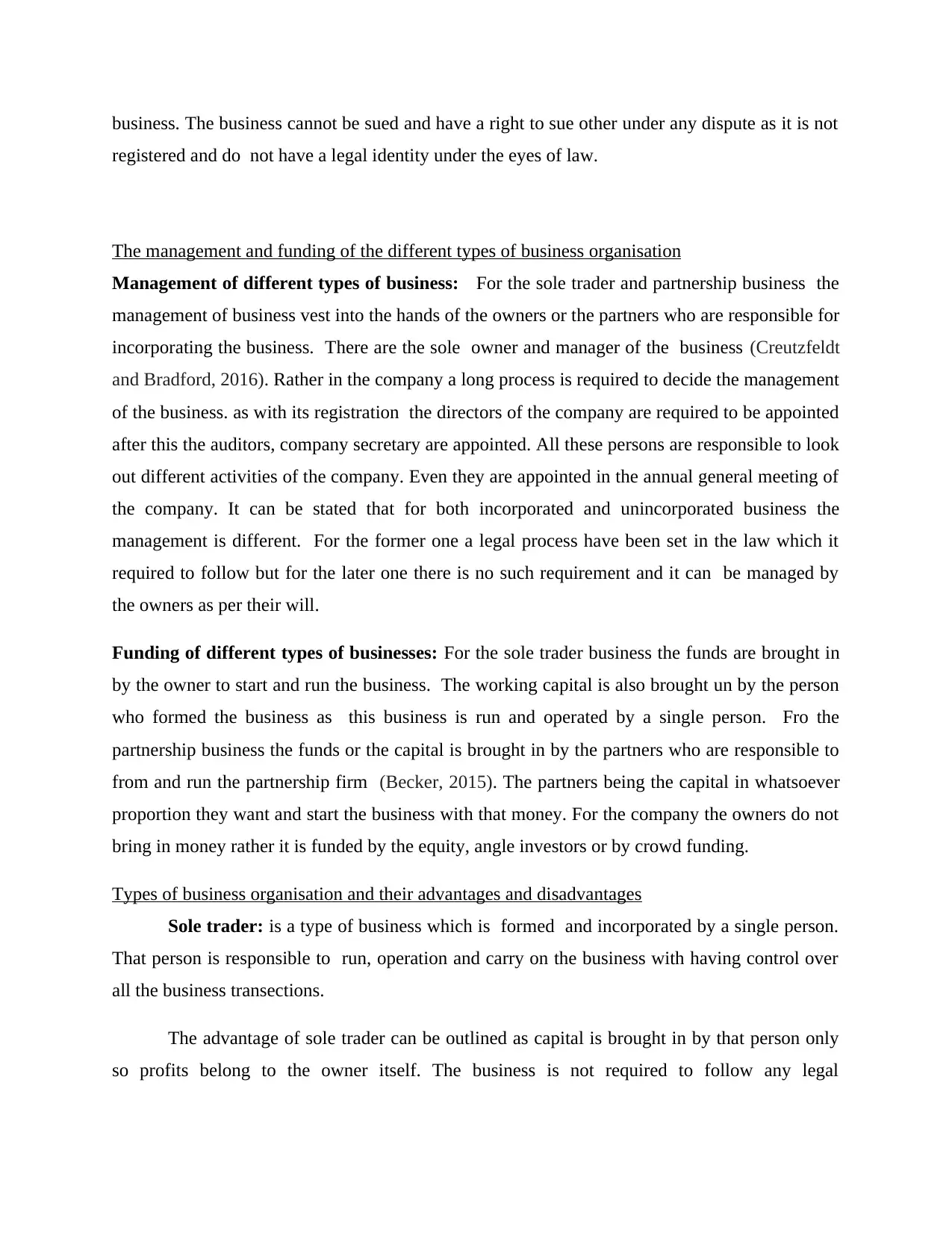
business. The business cannot be sued and have a right to sue other under any dispute as it is not
registered and do not have a legal identity under the eyes of law.
The management and funding of the different types of business organisation
Management of different types of business: For the sole trader and partnership business the
management of business vest into the hands of the owners or the partners who are responsible for
incorporating the business. There are the sole owner and manager of the business (Creutzfeldt
and Bradford, 2016). Rather in the company a long process is required to decide the management
of the business. as with its registration the directors of the company are required to be appointed
after this the auditors, company secretary are appointed. All these persons are responsible to look
out different activities of the company. Even they are appointed in the annual general meeting of
the company. It can be stated that for both incorporated and unincorporated business the
management is different. For the former one a legal process have been set in the law which it
required to follow but for the later one there is no such requirement and it can be managed by
the owners as per their will.
Funding of different types of businesses: For the sole trader business the funds are brought in
by the owner to start and run the business. The working capital is also brought un by the person
who formed the business as this business is run and operated by a single person. Fro the
partnership business the funds or the capital is brought in by the partners who are responsible to
from and run the partnership firm (Becker, 2015). The partners being the capital in whatsoever
proportion they want and start the business with that money. For the company the owners do not
bring in money rather it is funded by the equity, angle investors or by crowd funding.
Types of business organisation and their advantages and disadvantages
Sole trader: is a type of business which is formed and incorporated by a single person.
That person is responsible to run, operation and carry on the business with having control over
all the business transections.
The advantage of sole trader can be outlined as capital is brought in by that person only
so profits belong to the owner itself. The business is not required to follow any legal
registered and do not have a legal identity under the eyes of law.
The management and funding of the different types of business organisation
Management of different types of business: For the sole trader and partnership business the
management of business vest into the hands of the owners or the partners who are responsible for
incorporating the business. There are the sole owner and manager of the business (Creutzfeldt
and Bradford, 2016). Rather in the company a long process is required to decide the management
of the business. as with its registration the directors of the company are required to be appointed
after this the auditors, company secretary are appointed. All these persons are responsible to look
out different activities of the company. Even they are appointed in the annual general meeting of
the company. It can be stated that for both incorporated and unincorporated business the
management is different. For the former one a legal process have been set in the law which it
required to follow but for the later one there is no such requirement and it can be managed by
the owners as per their will.
Funding of different types of businesses: For the sole trader business the funds are brought in
by the owner to start and run the business. The working capital is also brought un by the person
who formed the business as this business is run and operated by a single person. Fro the
partnership business the funds or the capital is brought in by the partners who are responsible to
from and run the partnership firm (Becker, 2015). The partners being the capital in whatsoever
proportion they want and start the business with that money. For the company the owners do not
bring in money rather it is funded by the equity, angle investors or by crowd funding.
Types of business organisation and their advantages and disadvantages
Sole trader: is a type of business which is formed and incorporated by a single person.
That person is responsible to run, operation and carry on the business with having control over
all the business transections.
The advantage of sole trader can be outlined as capital is brought in by that person only
so profits belong to the owner itself. The business is not required to follow any legal
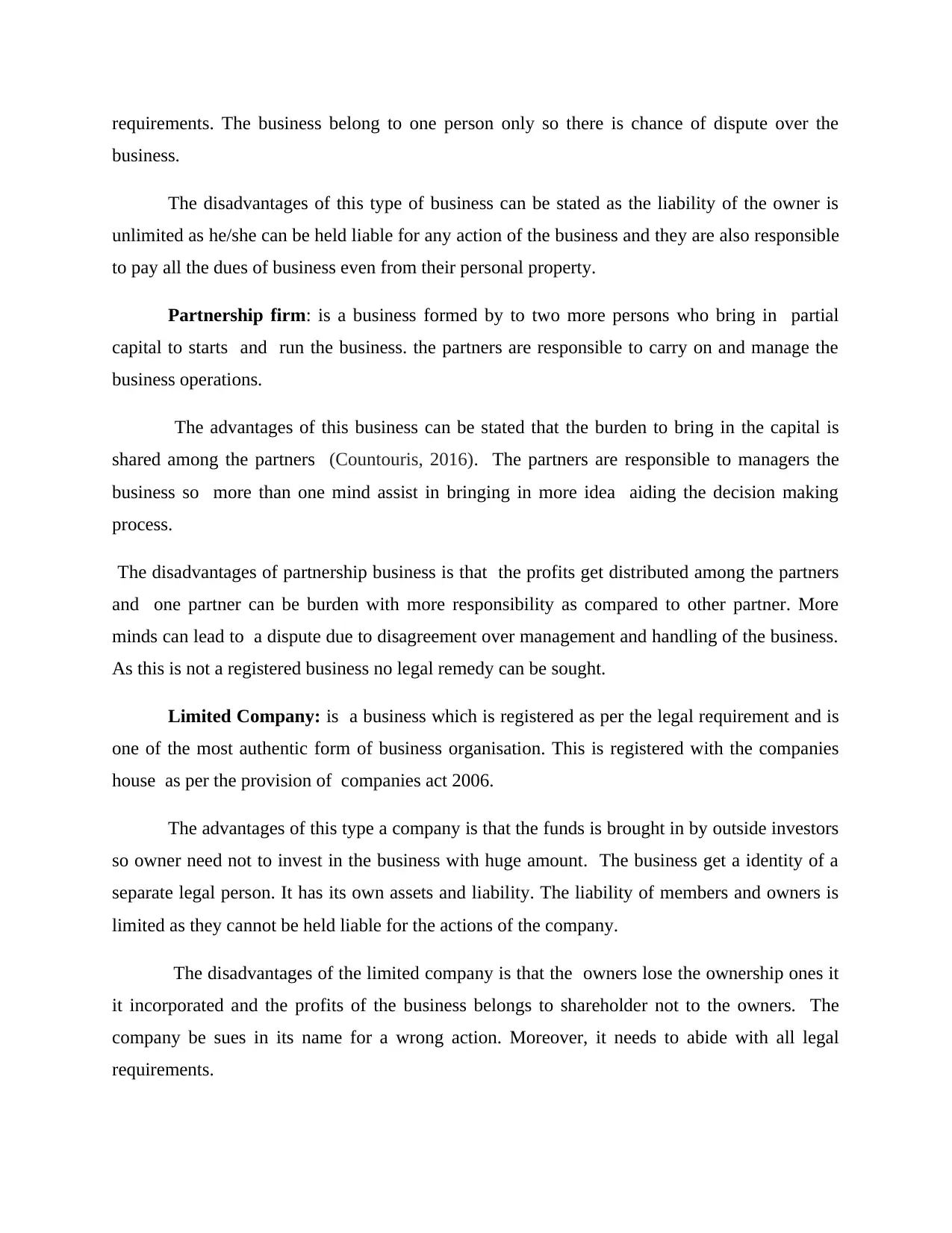
requirements. The business belong to one person only so there is chance of dispute over the
business.
The disadvantages of this type of business can be stated as the liability of the owner is
unlimited as he/she can be held liable for any action of the business and they are also responsible
to pay all the dues of business even from their personal property.
Partnership firm: is a business formed by to two more persons who bring in partial
capital to starts and run the business. the partners are responsible to carry on and manage the
business operations.
The advantages of this business can be stated that the burden to bring in the capital is
shared among the partners (Countouris, 2016). The partners are responsible to managers the
business so more than one mind assist in bringing in more idea aiding the decision making
process.
The disadvantages of partnership business is that the profits get distributed among the partners
and one partner can be burden with more responsibility as compared to other partner. More
minds can lead to a dispute due to disagreement over management and handling of the business.
As this is not a registered business no legal remedy can be sought.
Limited Company: is a business which is registered as per the legal requirement and is
one of the most authentic form of business organisation. This is registered with the companies
house as per the provision of companies act 2006.
The advantages of this type a company is that the funds is brought in by outside investors
so owner need not to invest in the business with huge amount. The business get a identity of a
separate legal person. It has its own assets and liability. The liability of members and owners is
limited as they cannot be held liable for the actions of the company.
The disadvantages of the limited company is that the owners lose the ownership ones it
it incorporated and the profits of the business belongs to shareholder not to the owners. The
company be sues in its name for a wrong action. Moreover, it needs to abide with all legal
requirements.
business.
The disadvantages of this type of business can be stated as the liability of the owner is
unlimited as he/she can be held liable for any action of the business and they are also responsible
to pay all the dues of business even from their personal property.
Partnership firm: is a business formed by to two more persons who bring in partial
capital to starts and run the business. the partners are responsible to carry on and manage the
business operations.
The advantages of this business can be stated that the burden to bring in the capital is
shared among the partners (Countouris, 2016). The partners are responsible to managers the
business so more than one mind assist in bringing in more idea aiding the decision making
process.
The disadvantages of partnership business is that the profits get distributed among the partners
and one partner can be burden with more responsibility as compared to other partner. More
minds can lead to a dispute due to disagreement over management and handling of the business.
As this is not a registered business no legal remedy can be sought.
Limited Company: is a business which is registered as per the legal requirement and is
one of the most authentic form of business organisation. This is registered with the companies
house as per the provision of companies act 2006.
The advantages of this type a company is that the funds is brought in by outside investors
so owner need not to invest in the business with huge amount. The business get a identity of a
separate legal person. It has its own assets and liability. The liability of members and owners is
limited as they cannot be held liable for the actions of the company.
The disadvantages of the limited company is that the owners lose the ownership ones it
it incorporated and the profits of the business belongs to shareholder not to the owners. The
company be sues in its name for a wrong action. Moreover, it needs to abide with all legal
requirements.
Secure Best Marks with AI Grader
Need help grading? Try our AI Grader for instant feedback on your assignments.
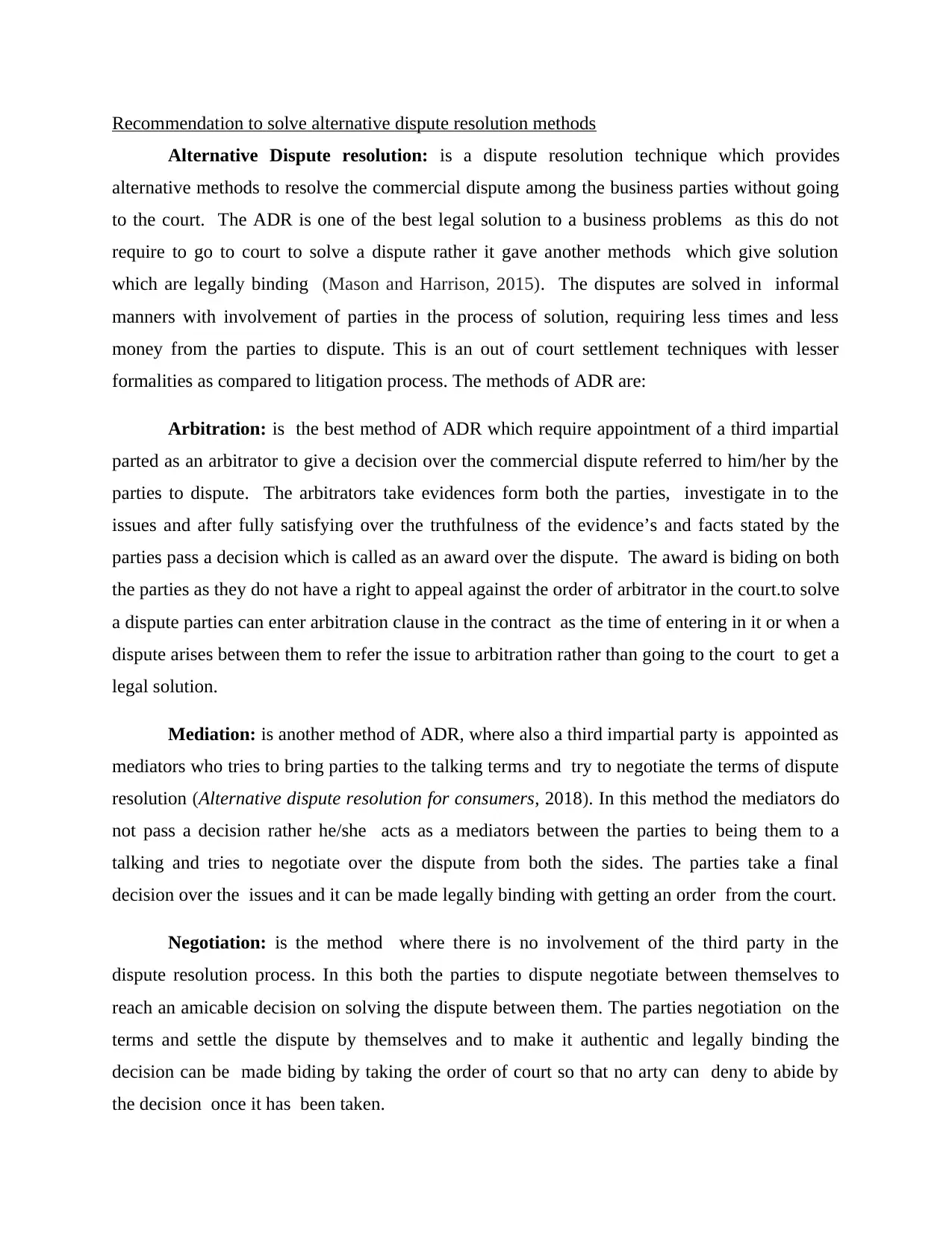
Recommendation to solve alternative dispute resolution methods
Alternative Dispute resolution: is a dispute resolution technique which provides
alternative methods to resolve the commercial dispute among the business parties without going
to the court. The ADR is one of the best legal solution to a business problems as this do not
require to go to court to solve a dispute rather it gave another methods which give solution
which are legally binding (Mason and Harrison, 2015). The disputes are solved in informal
manners with involvement of parties in the process of solution, requiring less times and less
money from the parties to dispute. This is an out of court settlement techniques with lesser
formalities as compared to litigation process. The methods of ADR are:
Arbitration: is the best method of ADR which require appointment of a third impartial
parted as an arbitrator to give a decision over the commercial dispute referred to him/her by the
parties to dispute. The arbitrators take evidences form both the parties, investigate in to the
issues and after fully satisfying over the truthfulness of the evidence’s and facts stated by the
parties pass a decision which is called as an award over the dispute. The award is biding on both
the parties as they do not have a right to appeal against the order of arbitrator in the court.to solve
a dispute parties can enter arbitration clause in the contract as the time of entering in it or when a
dispute arises between them to refer the issue to arbitration rather than going to the court to get a
legal solution.
Mediation: is another method of ADR, where also a third impartial party is appointed as
mediators who tries to bring parties to the talking terms and try to negotiate the terms of dispute
resolution (Alternative dispute resolution for consumers, 2018). In this method the mediators do
not pass a decision rather he/she acts as a mediators between the parties to being them to a
talking and tries to negotiate over the dispute from both the sides. The parties take a final
decision over the issues and it can be made legally binding with getting an order from the court.
Negotiation: is the method where there is no involvement of the third party in the
dispute resolution process. In this both the parties to dispute negotiate between themselves to
reach an amicable decision on solving the dispute between them. The parties negotiation on the
terms and settle the dispute by themselves and to make it authentic and legally binding the
decision can be made biding by taking the order of court so that no arty can deny to abide by
the decision once it has been taken.
Alternative Dispute resolution: is a dispute resolution technique which provides
alternative methods to resolve the commercial dispute among the business parties without going
to the court. The ADR is one of the best legal solution to a business problems as this do not
require to go to court to solve a dispute rather it gave another methods which give solution
which are legally binding (Mason and Harrison, 2015). The disputes are solved in informal
manners with involvement of parties in the process of solution, requiring less times and less
money from the parties to dispute. This is an out of court settlement techniques with lesser
formalities as compared to litigation process. The methods of ADR are:
Arbitration: is the best method of ADR which require appointment of a third impartial
parted as an arbitrator to give a decision over the commercial dispute referred to him/her by the
parties to dispute. The arbitrators take evidences form both the parties, investigate in to the
issues and after fully satisfying over the truthfulness of the evidence’s and facts stated by the
parties pass a decision which is called as an award over the dispute. The award is biding on both
the parties as they do not have a right to appeal against the order of arbitrator in the court.to solve
a dispute parties can enter arbitration clause in the contract as the time of entering in it or when a
dispute arises between them to refer the issue to arbitration rather than going to the court to get a
legal solution.
Mediation: is another method of ADR, where also a third impartial party is appointed as
mediators who tries to bring parties to the talking terms and try to negotiate the terms of dispute
resolution (Alternative dispute resolution for consumers, 2018). In this method the mediators do
not pass a decision rather he/she acts as a mediators between the parties to being them to a
talking and tries to negotiate over the dispute from both the sides. The parties take a final
decision over the issues and it can be made legally binding with getting an order from the court.
Negotiation: is the method where there is no involvement of the third party in the
dispute resolution process. In this both the parties to dispute negotiate between themselves to
reach an amicable decision on solving the dispute between them. The parties negotiation on the
terms and settle the dispute by themselves and to make it authentic and legally binding the
decision can be made biding by taking the order of court so that no arty can deny to abide by
the decision once it has been taken.
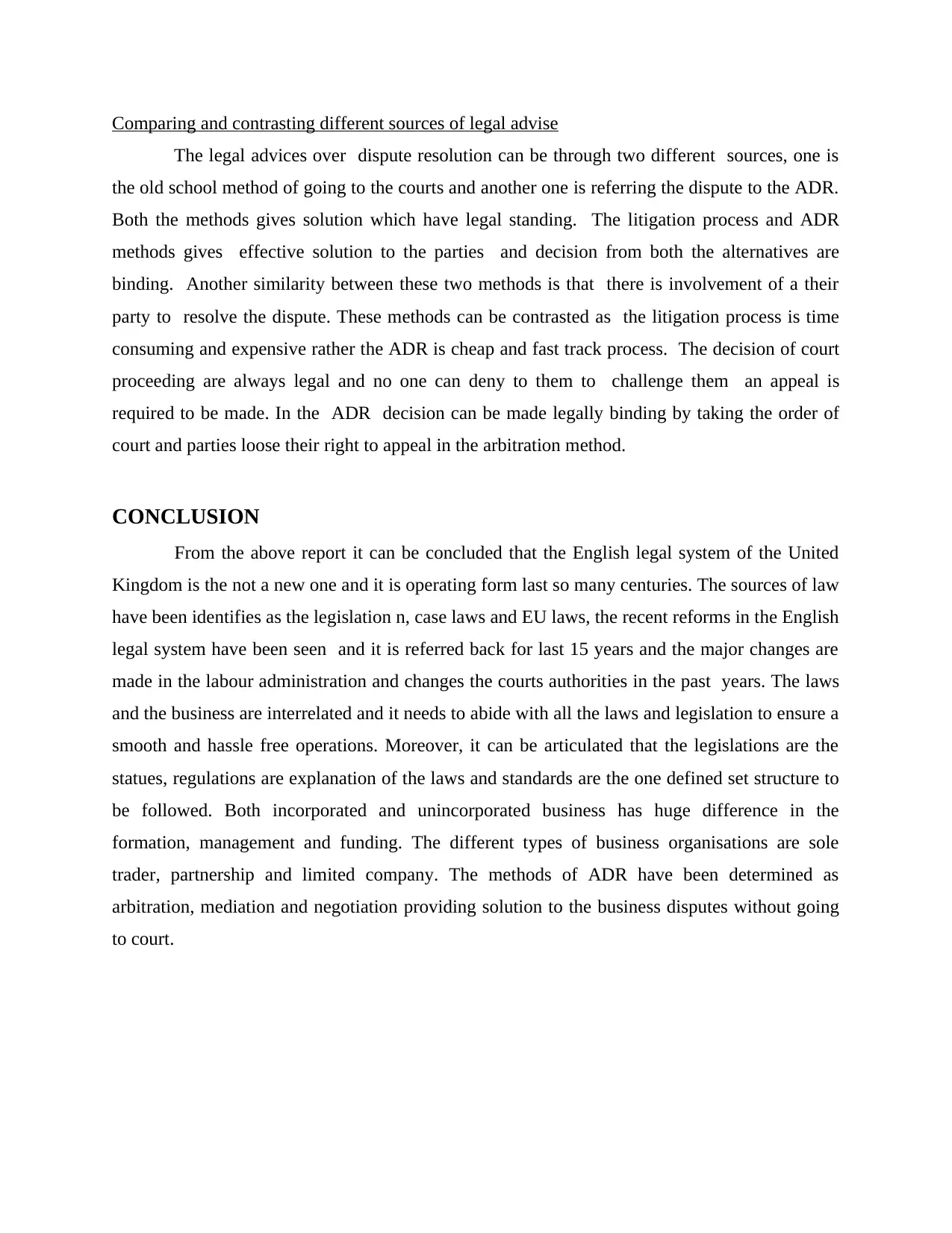
Comparing and contrasting different sources of legal advise
The legal advices over dispute resolution can be through two different sources, one is
the old school method of going to the courts and another one is referring the dispute to the ADR.
Both the methods gives solution which have legal standing. The litigation process and ADR
methods gives effective solution to the parties and decision from both the alternatives are
binding. Another similarity between these two methods is that there is involvement of a their
party to resolve the dispute. These methods can be contrasted as the litigation process is time
consuming and expensive rather the ADR is cheap and fast track process. The decision of court
proceeding are always legal and no one can deny to them to challenge them an appeal is
required to be made. In the ADR decision can be made legally binding by taking the order of
court and parties loose their right to appeal in the arbitration method.
CONCLUSION
From the above report it can be concluded that the English legal system of the United
Kingdom is the not a new one and it is operating form last so many centuries. The sources of law
have been identifies as the legislation n, case laws and EU laws, the recent reforms in the English
legal system have been seen and it is referred back for last 15 years and the major changes are
made in the labour administration and changes the courts authorities in the past years. The laws
and the business are interrelated and it needs to abide with all the laws and legislation to ensure a
smooth and hassle free operations. Moreover, it can be articulated that the legislations are the
statues, regulations are explanation of the laws and standards are the one defined set structure to
be followed. Both incorporated and unincorporated business has huge difference in the
formation, management and funding. The different types of business organisations are sole
trader, partnership and limited company. The methods of ADR have been determined as
arbitration, mediation and negotiation providing solution to the business disputes without going
to court.
The legal advices over dispute resolution can be through two different sources, one is
the old school method of going to the courts and another one is referring the dispute to the ADR.
Both the methods gives solution which have legal standing. The litigation process and ADR
methods gives effective solution to the parties and decision from both the alternatives are
binding. Another similarity between these two methods is that there is involvement of a their
party to resolve the dispute. These methods can be contrasted as the litigation process is time
consuming and expensive rather the ADR is cheap and fast track process. The decision of court
proceeding are always legal and no one can deny to them to challenge them an appeal is
required to be made. In the ADR decision can be made legally binding by taking the order of
court and parties loose their right to appeal in the arbitration method.
CONCLUSION
From the above report it can be concluded that the English legal system of the United
Kingdom is the not a new one and it is operating form last so many centuries. The sources of law
have been identifies as the legislation n, case laws and EU laws, the recent reforms in the English
legal system have been seen and it is referred back for last 15 years and the major changes are
made in the labour administration and changes the courts authorities in the past years. The laws
and the business are interrelated and it needs to abide with all the laws and legislation to ensure a
smooth and hassle free operations. Moreover, it can be articulated that the legislations are the
statues, regulations are explanation of the laws and standards are the one defined set structure to
be followed. Both incorporated and unincorporated business has huge difference in the
formation, management and funding. The different types of business organisations are sole
trader, partnership and limited company. The methods of ADR have been determined as
arbitration, mediation and negotiation providing solution to the business disputes without going
to court.
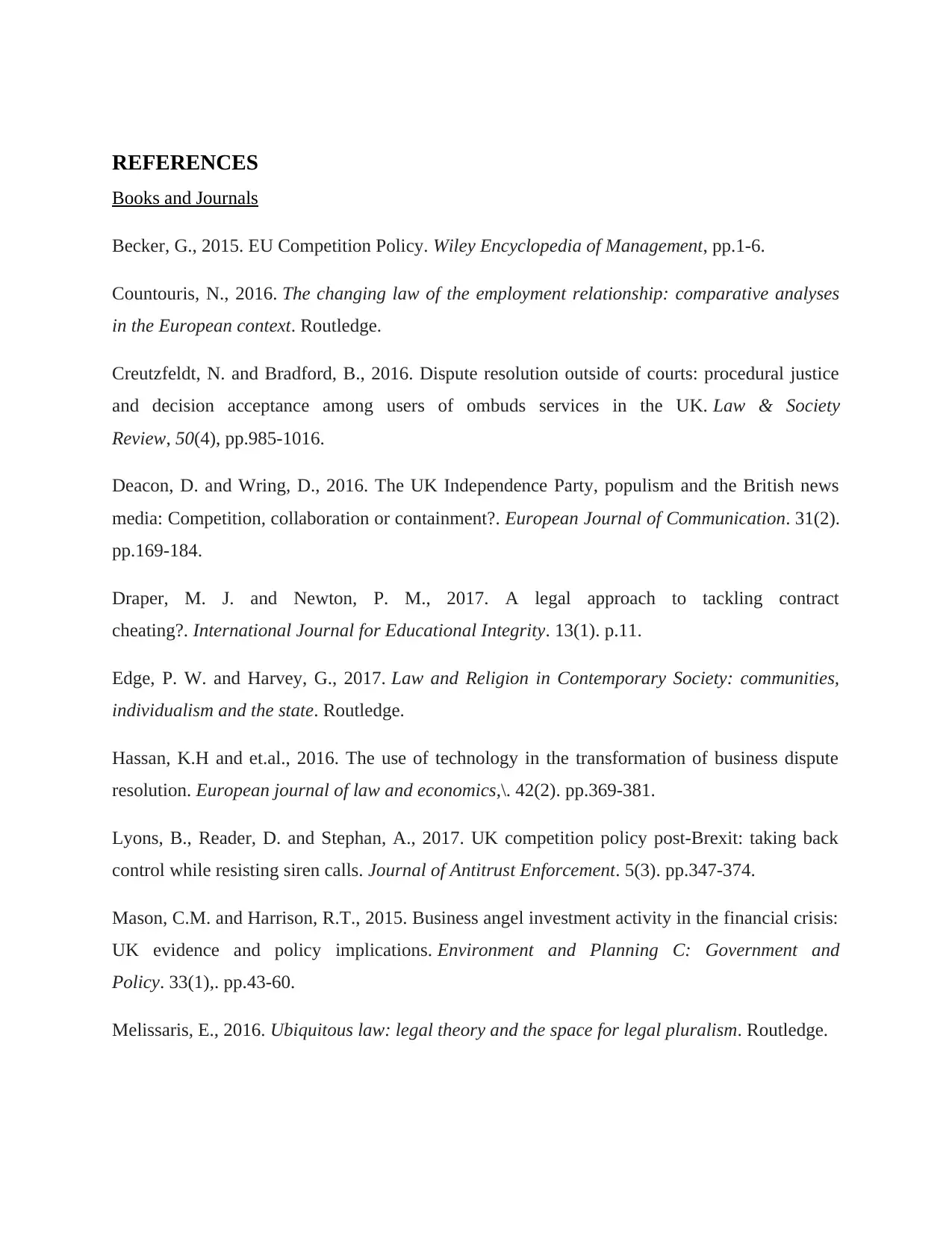
REFERENCES
Books and Journals
Becker, G., 2015. EU Competition Policy. Wiley Encyclopedia of Management, pp.1-6.
Countouris, N., 2016. The changing law of the employment relationship: comparative analyses
in the European context. Routledge.
Creutzfeldt, N. and Bradford, B., 2016. Dispute resolution outside of courts: procedural justice
and decision acceptance among users of ombuds services in the UK. Law & Society
Review, 50(4), pp.985-1016.
Deacon, D. and Wring, D., 2016. The UK Independence Party, populism and the British news
media: Competition, collaboration or containment?. European Journal of Communication. 31(2).
pp.169-184.
Draper, M. J. and Newton, P. M., 2017. A legal approach to tackling contract
cheating?. International Journal for Educational Integrity. 13(1). p.11.
Edge, P. W. and Harvey, G., 2017. Law and Religion in Contemporary Society: communities,
individualism and the state. Routledge.
Hassan, K.H and et.al., 2016. The use of technology in the transformation of business dispute
resolution. European journal of law and economics,\. 42(2). pp.369-381.
Lyons, B., Reader, D. and Stephan, A., 2017. UK competition policy post-Brexit: taking back
control while resisting siren calls. Journal of Antitrust Enforcement. 5(3). pp.347-374.
Mason, C.M. and Harrison, R.T., 2015. Business angel investment activity in the financial crisis:
UK evidence and policy implications. Environment and Planning C: Government and
Policy. 33(1),. pp.43-60.
Melissaris, E., 2016. Ubiquitous law: legal theory and the space for legal pluralism. Routledge.
Books and Journals
Becker, G., 2015. EU Competition Policy. Wiley Encyclopedia of Management, pp.1-6.
Countouris, N., 2016. The changing law of the employment relationship: comparative analyses
in the European context. Routledge.
Creutzfeldt, N. and Bradford, B., 2016. Dispute resolution outside of courts: procedural justice
and decision acceptance among users of ombuds services in the UK. Law & Society
Review, 50(4), pp.985-1016.
Deacon, D. and Wring, D., 2016. The UK Independence Party, populism and the British news
media: Competition, collaboration or containment?. European Journal of Communication. 31(2).
pp.169-184.
Draper, M. J. and Newton, P. M., 2017. A legal approach to tackling contract
cheating?. International Journal for Educational Integrity. 13(1). p.11.
Edge, P. W. and Harvey, G., 2017. Law and Religion in Contemporary Society: communities,
individualism and the state. Routledge.
Hassan, K.H and et.al., 2016. The use of technology in the transformation of business dispute
resolution. European journal of law and economics,\. 42(2). pp.369-381.
Lyons, B., Reader, D. and Stephan, A., 2017. UK competition policy post-Brexit: taking back
control while resisting siren calls. Journal of Antitrust Enforcement. 5(3). pp.347-374.
Mason, C.M. and Harrison, R.T., 2015. Business angel investment activity in the financial crisis:
UK evidence and policy implications. Environment and Planning C: Government and
Policy. 33(1),. pp.43-60.
Melissaris, E., 2016. Ubiquitous law: legal theory and the space for legal pluralism. Routledge.
Paraphrase This Document
Need a fresh take? Get an instant paraphrase of this document with our AI Paraphraser
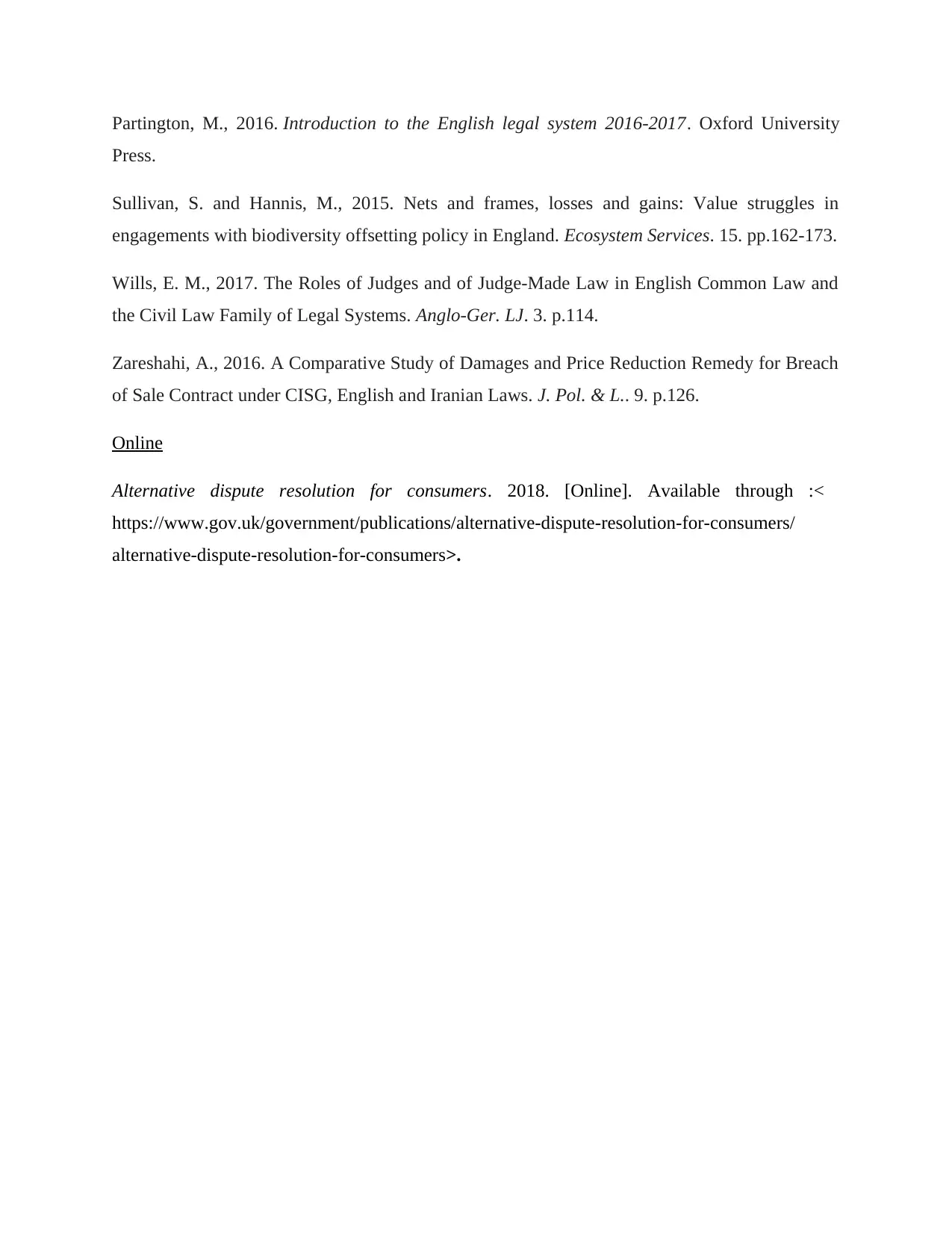
Partington, M., 2016. Introduction to the English legal system 2016-2017. Oxford University
Press.
Sullivan, S. and Hannis, M., 2015. Nets and frames, losses and gains: Value struggles in
engagements with biodiversity offsetting policy in England. Ecosystem Services. 15. pp.162-173.
Wills, E. M., 2017. The Roles of Judges and of Judge-Made Law in English Common Law and
the Civil Law Family of Legal Systems. Anglo-Ger. LJ. 3. p.114.
Zareshahi, A., 2016. A Comparative Study of Damages and Price Reduction Remedy for Breach
of Sale Contract under CISG, English and Iranian Laws. J. Pol. & L.. 9. p.126.
Online
Alternative dispute resolution for consumers. 2018. [Online]. Available through :<
https://www.gov.uk/government/publications/alternative-dispute-resolution-for-consumers/
alternative-dispute-resolution-for-consumers>.
Press.
Sullivan, S. and Hannis, M., 2015. Nets and frames, losses and gains: Value struggles in
engagements with biodiversity offsetting policy in England. Ecosystem Services. 15. pp.162-173.
Wills, E. M., 2017. The Roles of Judges and of Judge-Made Law in English Common Law and
the Civil Law Family of Legal Systems. Anglo-Ger. LJ. 3. p.114.
Zareshahi, A., 2016. A Comparative Study of Damages and Price Reduction Remedy for Breach
of Sale Contract under CISG, English and Iranian Laws. J. Pol. & L.. 9. p.126.
Online
Alternative dispute resolution for consumers. 2018. [Online]. Available through :<
https://www.gov.uk/government/publications/alternative-dispute-resolution-for-consumers/
alternative-dispute-resolution-for-consumers>.
1 out of 14
Related Documents
Your All-in-One AI-Powered Toolkit for Academic Success.
+13062052269
info@desklib.com
Available 24*7 on WhatsApp / Email
![[object Object]](/_next/static/media/star-bottom.7253800d.svg)
Unlock your academic potential
© 2024 | Zucol Services PVT LTD | All rights reserved.





